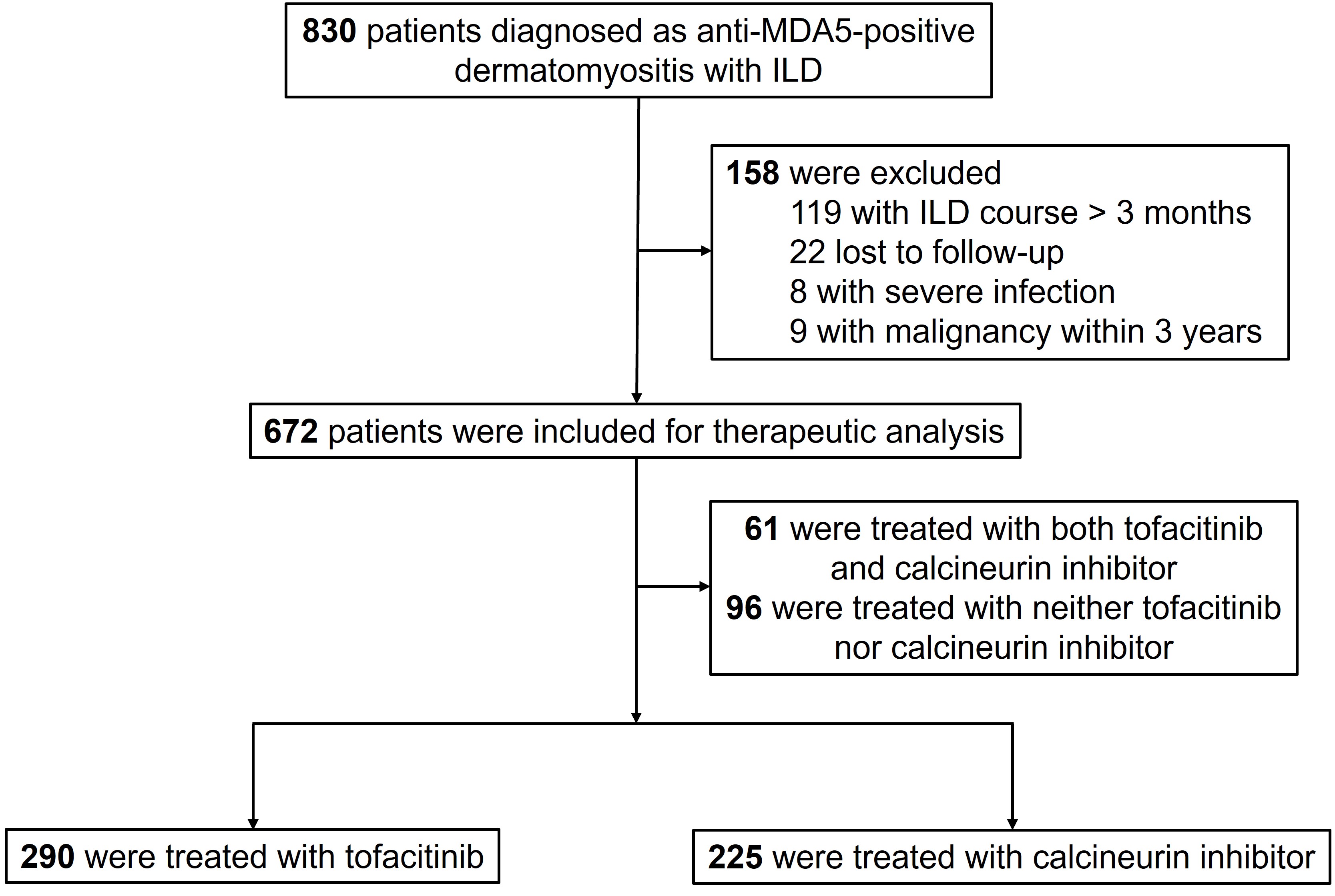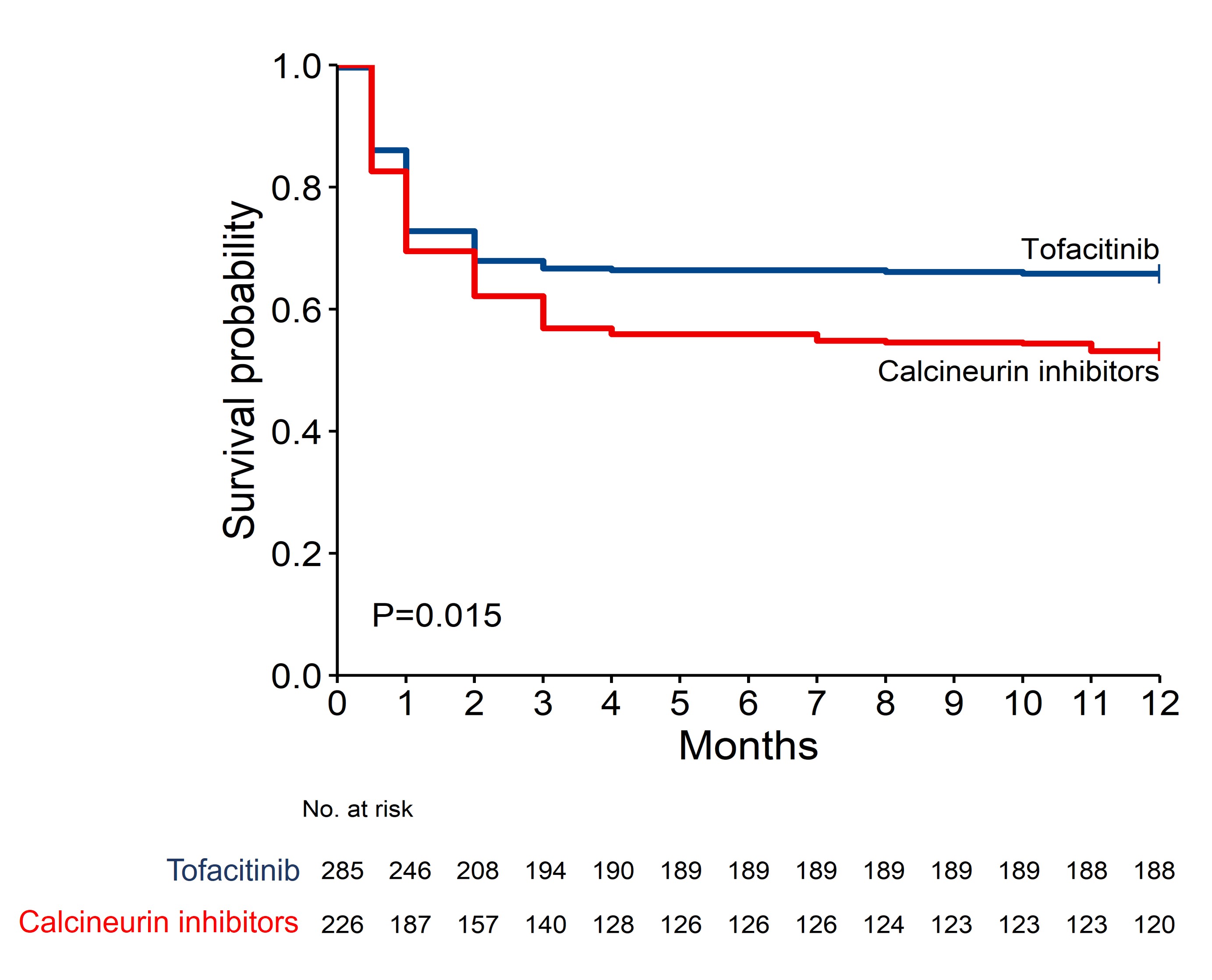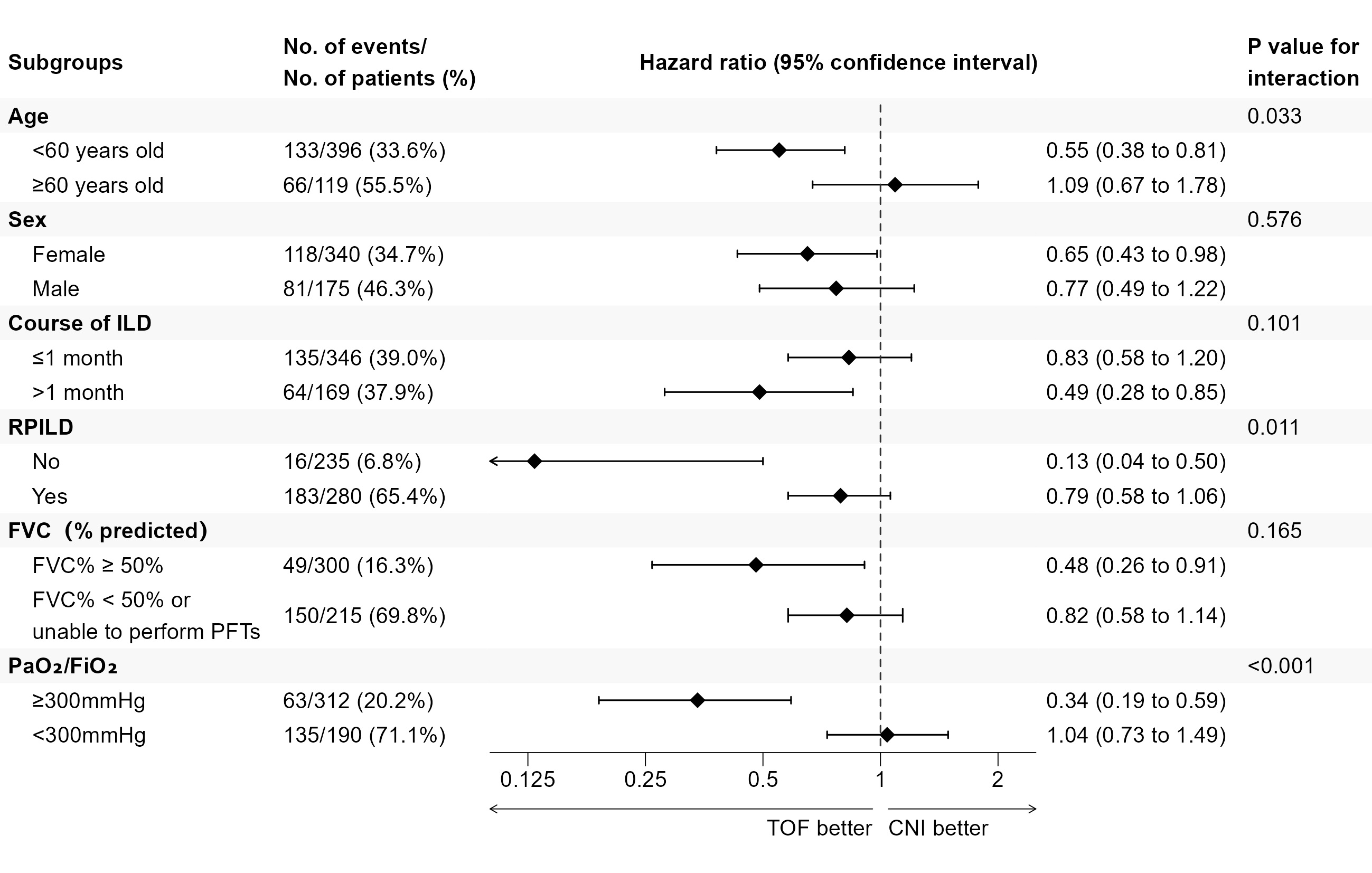Session Information
Date: Sunday, November 17, 2024
Title: Abstracts: Muscle Biology, Myositis & Myopathies – Basic & Clinical Science I
Session Type: Abstract Session
Session Time: 3:00PM-4:30PM
Background/Purpose: The current management of anti-melanoma differentiation-associated gene 5-positive dermatomyositis (MDA5+DM) is challenging and largely empirical rather than evidence-based. Small-sized proof-of-concept trial and case series have reported favorable treatment response using tofacitinib in both new-onset and refractory interstitial lung disease (ILD) secondary to MDA5+DM. This study aimed to compare the effectiveness and safety of tofacitinib (TOF) versus calcineurin inhibitor (CNI) as initial immunosuppressive regimen for MDA5+DM-ILD in a large multi-center cohort.
Methods: Adult Chinese patients with newly-diagnosed MDA5+DM-ILD (ILD course < 3 months), which fulfilled the 239th European Neuromuscular Center (ENMC) criteria for dermatomyositis, from five tertiary referral centers between April 2014 and January 2023 were included for this cohort study. Dummy variable was applied to address missing data. Propensity score-based inverse probability of treatment weighting (IPTW) with 14 confounding covariates for survival was applied for adjustment in this real-world study. Kaplan-Meier curves were plotted and log-rank test results were reported to compare the lung transplantation-free survival within 1 year between TOF and CNI group based on IPTW dataset. Sensitivity and exploratory subgroup analyses were also performed.
Results: In the eligible cohort (Figure 1), a total of 94 (32.4%) and 105 (46.7%) patients died or underwent lung transplantation within 1 year in the TOF group (n=290) and the CNI group (n=225), respectively. With baseline prognostic factors well-balanced by IPTW, patients’ lung transplantation-free survival rate within 1 year was significantly higher in the TOF group compared to the CNI group (log-rank P=0.015) (Figure 2). Multivariable Cox analysis performed in the IPTW dataset revealed the hazard ratio of TOF versus CNI for 1-year survival was 0.70 (95% CI, 0.51 to 0.95, P=0.022). The adjusted difference of survival rate was 9.9% (95%CI 3.4% to 16.4%) between treatment groups. Alternative analytic strategies yielded consistent results, including multivariable Cox regression using multiple imputation addressing missing data followed by IPTW (HR, 0.68; 95% CI, 0.53 to 0.87), and multivariable Cox regression using dummy variable addressing missing data in the raw dataset (HR, 0.70; 95% CI, 0.52 to 0.96). In the exploratory subgroup analysis stratified by baseline prognostic factors (Figure 3), based on P values for interaction, patients < 60 years old might be associated with a lower mortality when treated with tofacitinib (HR, 0.55; 95% CI, 0.38 to 0.81). Patients without rapidly progressive interstitial lung disease (RPILD) probably benefit more from TOF than CNI (HR, 0.13; 95% CI, 0.04 to 0.50). Patients with baseline PaO2/FiO2 ≥ 300mmHg might also benefit more from tofacitinib (HR, 0.34; 95% CI, 0.19 to 0.59). Opportunistic infection was the major treatment-related serious adverse event, with generally comparable incidence (41.0% vs. 46.2%, P=0.239).
Conclusion: In this large multi-center cohort study, tofacitinib showed significantly more benefits for 1-year lung transplantation-free survival than calcineurin inhibitors in MDA5+DM-ILD.
To cite this abstract in AMA style:
Wu W, Guo B, Sun W, Chen D, Xu W, Chen Z, Fu Y, Ye Y, Lyu X, Xue Z, Wang K, Zhao J, Ye C, Dai M, Fan W, Li J, Wang X, Xue Y, Wan W, Sun L, Wu H, Luo Q, Han Q, Fu Q, Ye S. Effectiveness and Safety of Tofacitinib vs. Calcineurin Inhibitor in Interstitial Lung Disease Secondary to Anti-Melanoma Differentiation-Associated Gene 5-Positive Dermatomyositis: A Multi-Center Cohort Study with Propensity Score-Based Inverse Probability of Treatment Weighting [abstract]. Arthritis Rheumatol. 2024; 76 (suppl 9). https://acrabstracts.org/abstract/effectiveness-and-safety-of-tofacitinib-vs-calcineurin-inhibitor-in-interstitial-lung-disease-secondary-to-anti-melanoma-differentiation-associated-gene-5-positive-dermatomyositis-a-multi-center-coh/. Accessed .« Back to ACR Convergence 2024
ACR Meeting Abstracts - https://acrabstracts.org/abstract/effectiveness-and-safety-of-tofacitinib-vs-calcineurin-inhibitor-in-interstitial-lung-disease-secondary-to-anti-melanoma-differentiation-associated-gene-5-positive-dermatomyositis-a-multi-center-coh/



